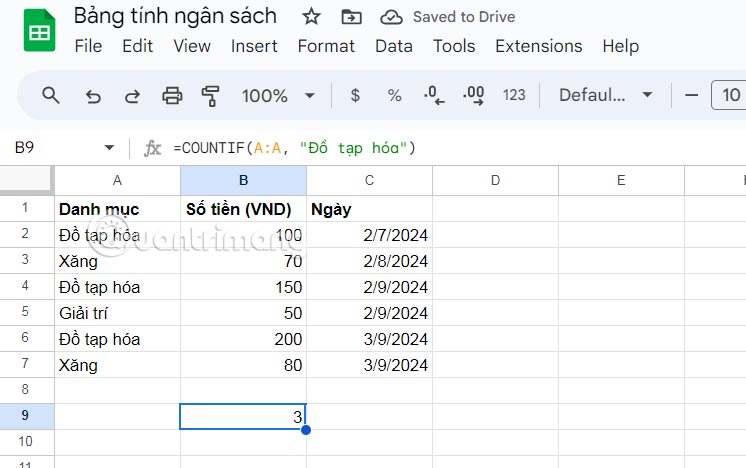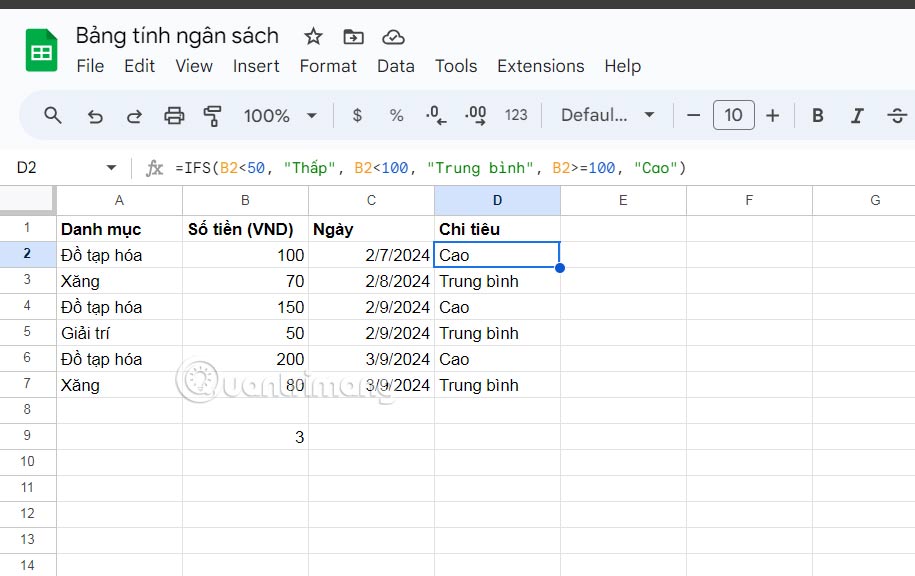Google Sheets Functions to Simplify Your Budget Spreadsheets
Budget spreadsheets are powerful tools for managing your finances, but with all the data and calculations involved, they can quickly become overwhelming. These Google Sheets functions help you track your expenses, manage your income, and stay on track with your financial goals.
Budget function in Google Sheets
AVERAGEIF
The AVERAGEIF function helps you calculate the average of a group of numbers in a range of cells that meet specific criteria. The syntax for this function is:
=AVERAGEIF(phạm vi, tiêu chí, [phạm vi_trung_bình])
Where range is the range of cells you want to evaluate, criteria is the condition that must be met, and [average_range] is the range of cells for which the average value should be calculated.
For example:
Let's say you're planning to create a budget spreadsheet that tracks various expenses along with their corresponding dates, as in the example below.
To find the average amount you spend on groceries, where "Grocery" is listed in column A and the amount is in column B, use the formula:
=AVERAGEIF(A:A, "Đồ tạp hóa", B:B)

You will get the result as 150 VND
SUMIF
SUMIF allows you to sum values in a range that meet specific criteria. The syntax for the SUMIF function is:
=SUMIF(phạm vi, tiêu chí, [phạm vi tổng])
Where range is the range of cells to be evaluated, criteria is the condition to be met, and [sum range] is the range of cells to be summed.
For example:
If you want to calculate your total grocery shopping cost, use the formula:
=SUMIF(A:A, "Đồ tạp hóa", B:B)

COUNTIF
With COUNTIF, you can count the number of cells in a range that meet specific criteria. This makes it easier to track the frequency of certain expenses.
The syntax of the COUNTIF function is:
=COUNTIF(phạm vi, tiêu chí)
Where range is the range of cells to count and criteria is the condition that must be met.
For example:
To calculate the number of grocery purchases, use the formula:
=COUNTIF(A:A, "Đồ tạp hóa")

IFS
IFS is a more advanced function that allows you to check multiple conditions. This function is useful for classifying expenses based on different criteria.
The syntax of the IFS function is:
=IFS(điều kiện1, giá trị_nếu_đúng1, [điều kiện2, giá trị_nếu_đúng2], .)
Condition1 is the first condition to evaluate and if_true1 is the result if the condition is true. You can add multiple conditions and their corresponding results.
For example:
If you want to categorize your spending based on dollar amount, use the formula:
=IFS(B2<50, "Thấp", B2<100, "Trung bình", B2>=100, "Cao")
This formula will label each expense as Low, Medium, or High based on the amount. For example, a $150 grocery purchase would be classified as High, as shown in the screenshot below.

TEXT
The TEXT function formats numbers as text, useful for displaying numbers in an easy-to-read way (currency or percentage).
The syntax of the TEXT function is:
=TEXT(value, format_text)
Where value is the number you want to format and format_text is the desired format (like currency or percentage).
For example:
To display a number as currency, use the formula:
=TEXT(B2, "VND#,##0.00")
Since cell B2 contains 150, the TEXT formula displays that number as 150.00VND to clarify that the cell's value represents money.

Above are useful budget calculation functions in Google Sheets. Hope the article is useful to you.
You should read it
- How to align spreadsheets before printing on Google Sheets
- How to enter 0 in Google Sheets
- How to create a phone number can be called on Google Sheets
- How to view editing history on Google Sheets
- 6 useful functions in Google Sheets you may not know yet
- How to fix Google Sheets not allowing scrolling
- How to count words on Google Sheets
- How to set up the right to edit spreadsheets on Google Sheets
May be interested
- 30+ useful Google Sheets functions
 google sheets is a great alternative to microsoft excel. it's packed with useful features, including a wide range of functions that cover most of those available on excel and more.
google sheets is a great alternative to microsoft excel. it's packed with useful features, including a wide range of functions that cover most of those available on excel and more. - How to use and customize themes in Google Sheets
 if you want to add consistency and aesthetics to your google sheets spreadsheets, consider using custom interfaces.
if you want to add consistency and aesthetics to your google sheets spreadsheets, consider using custom interfaces. - How to generate random numbers in Google Sheets
 google sheets provides a simple function for generating random numbers in spreadsheets without leaving the document or installing add-ons. this function returns a random integer between two values. and this is how to use it.
google sheets provides a simple function for generating random numbers in spreadsheets without leaving the document or installing add-ons. this function returns a random integer between two values. and this is how to use it. - 9 basic Google Sheets functions you should know
 functions are a key component of spreadsheet applications like google sheets. but if you rarely use them or are just starting out, they can be overwhelming.
functions are a key component of spreadsheet applications like google sheets. but if you rarely use them or are just starting out, they can be overwhelming. - How to count on multiple sheets of Google Sheets
 to sum a cell or region on multiple sheets on google sheets, users will still use the sum function.
to sum a cell or region on multiple sheets on google sheets, users will still use the sum function. - 5 Best Google Sheets Add-ons to Make Data Analysis Easier
 google sheets is a powerful tool for data analysis, but sometimes you need more power. there are plenty of add-ons that can speed up your spreadsheets and take your data processing to the next level.
google sheets is a powerful tool for data analysis, but sometimes you need more power. there are plenty of add-ons that can speed up your spreadsheets and take your data processing to the next level. - How to count words on Google Sheets
 on google sheets, to count the number of words in each cell, users can use the formula with the counta function.
on google sheets, to count the number of words in each cell, users can use the formula with the counta function. - How to Use Google Spreadsheets
 on june 6, 2006, google released a spreadsheets product as a 'limited test' to a small number of users. that limited test stuck around, and google sheets is now widely used as a sub-feature of google docs. the product resembles a simple...
on june 6, 2006, google released a spreadsheets product as a 'limited test' to a small number of users. that limited test stuck around, and google sheets is now widely used as a sub-feature of google docs. the product resembles a simple... - This is a very useful function in Google Sheets but not many people know it
 there are times when you need to convert columns into rows or convert data from rows to columns, of course, retyping 'manually' takes time, so remember the transpose function,
there are times when you need to convert columns into rows or convert data from rows to columns, of course, retyping 'manually' takes time, so remember the transpose function, - How to create a filter in Google Sheets
 creating filters in google sheets helps you organize and analyze data easily, saving time working with spreadsheets. the following article will guide you on how to create filters in google sheets quickly and effectively.
creating filters in google sheets helps you organize and analyze data easily, saving time working with spreadsheets. the following article will guide you on how to create filters in google sheets quickly and effectively.










 How to fix 5 common 'disasters' when taking photos with smartphones
How to fix 5 common 'disasters' when taking photos with smartphones Bluetooth 6.0 brings new technology that helps Apple improve Find My network
Bluetooth 6.0 brings new technology that helps Apple improve Find My network What to Know About Peaklight: New Stealth Malware Targets Illegal Movie Downloads
What to Know About Peaklight: New Stealth Malware Targets Illegal Movie Downloads ExpressVPN Now Supports Windows ARM PCs
ExpressVPN Now Supports Windows ARM PCs YouTube's new parental controls make it easier to monitor teen creators
YouTube's new parental controls make it easier to monitor teen creators List of Samsung smartphones with the longest battery life
List of Samsung smartphones with the longest battery life